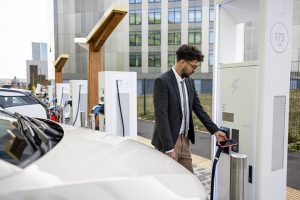Authored by Raghu (Jayaraman) Raghuraman, Senior Vice President, Digital Engineering & Technical Debt at Schneider Electric.
It takes time, precision, and dedication to create a reliable and robust IoT solution that would satisfy very specific requirements of industrial customers. As you can read in the blog of my product design colleagues, one of the best practices to create accurate and high quality IoT products is to involve customers from early design stage to implementation phase. Fortunately, the prototyping process that could last up to 12 months can now be shortened to 3 months thanks to the advances in digital technology we are implementing through engineering simulation.
Leading the digital transformation in energy management and industrial automation for our customers and partners, we aim to deliver solutions that meet the most exigent requirements throughout the lifecycle of our products – from power plants to CPG factories. In this blog, I reflect on the major drivers and success factors of engineering simulation in industrial environment.
Digital transformation at scale
Moving away from physical mockups to digital threads and digital twins seems like a natural evolution for us at Schneider Electric. Digital transformation at scale is a key pillar of our strategy – together with electrification and sustainability. We see electrification and digitization as inseparable and critical parts of the fight against climate change. This is the biggest challenge to humanity. By combining human and technology capabilities across various enablers such as artificial intelligence (AI), data, IT, or the digital ecosystem we can support the digitization efforts and sustainability ambitions of our customers and partners.
On the industrial side, we support our customers’ digital transformation by bridging OT with IT through the EcoStruxure platform, our IoT system architecture. It connects everything in the customers’ enterprise from the shop floor to the top floor. Finally, the system collects critical data from sensors to the cloud and analyzes it to discover meaningful insights. Delivering such an open, digital architecture to our customers and partners creates an opportunity to innovate on solutions at a greater scale. This also allows us to face real-world sustainability and efficiency challenges more easily and effectively.

Engineering simulation imperative
We work in a regulated environment. Our customers depend on us to ensure that our solutions operate in very particular conditions. Thus, engineering simulation and the digitization of the whole life cycle of a IoT solution make it possible to meet regulatory and customer demands. Particularly in an industrial environment, we see three main factors that drive simulation engineering:
-
Ensuring quality, robustness, and reliability
First, quality, is determined by the design. Our engineering efforts are focused on the reliability of our offers. The continuous improvement approach is helping to strive for quality perfection. Yet, it is simulation engineering that is taking these efforts to the next level. It enables better accuracy of improvements and simplifies the process of designing better products. When we simulate, we not only look at the specifications of the product but also at how it performs in extreme conditions.
Example: One of our customers is a nuclear plant. There is ZERO tolerance for failure. Usually, our products are sustained for twenty-five years. However, when a customer requests to double the product lifespan, we need to demonstrate the ways we can ensure that. If the request from the customer is for a feature extension or a particular product behavior, we need to demonstrate it as fast as possible and prove and guarantee the product’s reliability. Simulation helps us solve this challenge in a short time span.
-
Diving deep into customers’ requirements
We listen and prioritize our customers’ requirements first. We make sure each requirement is carefully analyzed and verified before it enters the production phase. Therefore, we go deeper into the specific data level, enabled by engineering simulation. For example, we are working with our customers in Europe on specific switchgear. We bring our customer earlier into the design cycle to show the simulation model with the data they provide. This way we simulate product performance which can differ depending on changing conditions and customer needs.
-
Being agile: experiment, learn, and scale
Today, customer expectations and behaviors are changing incredibly fast. If you’re not able to follow them, you can lose your customer’s trust. However, we can easily hit a snag here in industrial IoT product development. One of the reocurring limitations is to quickly implement customer feedback based on the interaction with the physical product mockup. How many physical mockups should we prepare to satisfy a customer – one, ten, or a hundred? This is certainly not an agile approach.
Implementing changes in the digital mockup is faster and more cost-efficient. We can demonstrate the usage of the suggested solution long before it is built. Additionally, it enables better agility of advanced offers where the architecture design is more complex, e.g., physical products, edge control devices, and software applications.
Lastly, by combing engineering simulation with Augmented Reality (AR) and Virtual Reality (VR), we can create a digital thread by simulating and shaping a digital twin for a realistic representation of our offers. This way we ensure accuracy, cost reduction, and faster go-to-market. We can also learn and scale with our customers along the way.
Cybersecurity and openness are key
Looking at these drivers, we can’t forget about the critical success factor of using engineering simulation, such as cybersecurity and openness. From the cybersecurity standpoint, we must avoid issues when managing and sustaining the model in the future. As for openness, it is especially valid for us as we create and orchestrate an ecosystem of end-users, system integrators, and technology partners (ISVs), who can co-innovate around the Ecostruxure data and capabilities, to develop new ways of generating and capturing value from data.
Let’s talk digital
Digital technologies help us make decisions smarter, faster, and more precisely. The success of the digital transformation is marked by creating added business by being more agile, more sustainable, more flexible, and faster in supporting our customers in their business objectives and product requirements. Without any doubt, engineering simulation is an additional asset that when applied by the business, sets it firmly apart.
[Tweet “Without any doubt, engineering simulation is an additional asset that when applied by the business, sets it firmly apart.”]
Interested in designing and developing customer-oriented products?
Get to know us better! Learn how digital skills and new technologies create meaningful purpose here.
About the author
 Raghu (Jayaraman) Raghuraman, Senior Vice President, Digital Engineering & Technical Debt at Schneider Electric, is a software professional, with a passion for software, IT and Technology. He has over 35 years of experience in the technology industry. Raghu’s focus is on strong execution and operational leadership in software product development.
Raghu (Jayaraman) Raghuraman, Senior Vice President, Digital Engineering & Technical Debt at Schneider Electric, is a software professional, with a passion for software, IT and Technology. He has over 35 years of experience in the technology industry. Raghu’s focus is on strong execution and operational leadership in software product development.
He has an established track record of leadership in providing vision, direction, organization, and execution of technical strategies. One of the greatest strengths he brings to any organization is his vast experience and knowledge of working within Fortune 500 companies, delivering on IT & Technology transformation goals while managing large department budgets ranging from $100 – 500 Million (USD).
Raghu spent the first 16 years of his career in India, before moving his family to the USA. He has lived and worked in various countries and has continued to lead diverse international teams across the globe, including teams in China, Mexico, Brazil, France & India.



